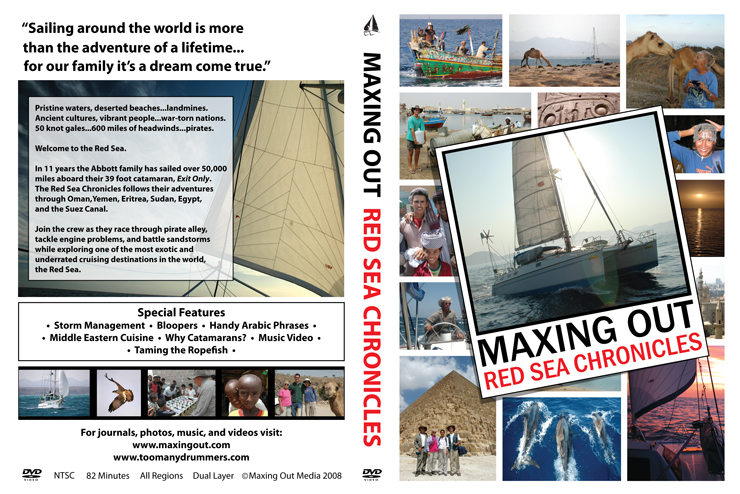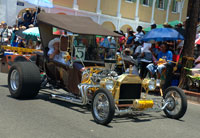
30 April 2006/Sunday/Charlotte
Amalie, St. Thomas, USVI
The waterfront area of Charlotte Amalie seemed very quiet this morning. The
music last night at The Village wasn't quite as loud as the music we heard
the previous nights, and it stopped about midnight last night instead of
going loud and strong until 0200 like the other nights. Last night was the
last planned activity for Carnival and was named "The Last Lap". I did not
open the hatches and turned on the fan for cool air when I went up in the
bunk to read before going to sleep. The sound wasn't too loud with the fan
running.
There were three huge cruise ships in first thing this morning. Dave and
I wondered if Havensight Mall, the shopping area directly next to the cruise
ship docks would be open today. They were closed for Carnival. We walked
around the edge of the bay about two miles to go see if the Docksides
Bookshop at Havensight was open. We still need to buy a cruising guide for
the Bahamas and someone told us to look there. Fortunately, there is a
Wendy's right outside the Havensight property, so we had a rest stop for a
cold drink and a frosty to keep our energy up.
Havensight Mall is made up of 4-6 large buildings. They have numbered the
buildings and I found it very confusing to find my way around. The cruise
ship passengers were totally disoriented and I saw several of them holding
their maps of the area upside-down. I wonder if the buildings were
color-coded instead of designated by numbers if the layout would be easier
for people to quickly figure out. The bookshop was quite difficult to find,
because it was closed. I thought I wasn't interested in anything else except
the guidebook, but I did happen to walk by a music shop and decided to buy
the CD of Jam Band singing "Super Hero", the popular song from the Carnival
Parade..."you're like Batman...Superman...Spiderman...". This was the song
honoring Nick Friday, who died of kidney failure last October. He was in Jam
Band.
While walking around Havensight, we met a couple from Detroit off one of
the Princess cruise ships. They said the ship carries 2,600 passengers and
it was full for this trip. The itinerary for this trip included leaving from
San Juan, Puerto Rico, going to St. Thomas, Antigua, and St. Martin/Sint
Maarten, then going off-shore to New York City. The passengers will
disembark in NYC and the ship will spend hurricane season doing cruises to
Martha's Vineyard, Nantucket, etc.
We took Elvin with us so we could stop at Pueblo Supermarket on the way
back to the boat. I bought quite a bit of fresh fruit and vegetables and
they are heavy to carry. I saw several American products on the shelves that
were new to me and looked like something we would want to try. I bought a
box of cooked bacon slices, ready to use. BLT's for lunch without
splattering grease in the galley and having to clean the stove!
We plan to check out of St. Thomas tomorrow morning and go to Culebra.
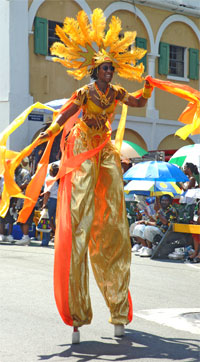 29 April 2006/Saturday/Charlotte Amalie, St. Thomas, USVI
29 April 2006/Saturday/Charlotte Amalie, St. Thomas, USVI
Everyone told us there would be many more people at the Adult Carnival
Parade today than attended the Children's Parade yesterday. We went to shore
at 0930. The newspaper said the parade would start at 1000. The spot where
we wanted to stand was already full of chairs when we arrived in front of
the post office. There was one open space among the chairs people brought.
There were a lot more people out today! Dave stood at the low wall near
where we stood yesterday. I stood with him until 1100. At that time I
crossed the street and found a marginally comfortable "seat" on a concrete
wall that came to a point rather than being flat on top. It was more like
"perching" than sitting. At least I was in the shade of a palm tree.
At 1100 a local dance group did a Quadrille demonstration. The Quadrille
is the official dance of The U.S Virgin Islands. Basically, it s a slow
square dance. The group was dressed colorfully in Madras plaids. The ladies
wore white tops with pretty lace trim. The dancing was alright, but they
kept dancing and dancing and dancing...filling in time while everyone was
waiting for the beginning of the parade to arrive at the judges' booth. The
first group in the parade arrived at the post office at 1130, so the parade
officially began.
There were more dancing baton twirlers today. The most popular song was
"Superhero" dedicated to Nicky Friday, the lead singer of Jam Band, who died
a year ago. He was very popular on St. Thomas. "Superhero" was written in
his memory...a catchy tune with words like "Just like Batman, Superman,
Spiderman".
At 1330 a group of Moko Jumbies came along. We didn't see many of these
in Trinidad. These are the guys and gals who are stilt walkers. This group
did several tricks on their stilts. One Moko Jumbie got overheated and the
caretakers who walk along with the group actually formed a horseshoe around
him so he could fall backwards on the stilts and the group caught him. They
untied the long scarves that were used to bind the stilt to the calf of his
leg. They took the man's feet out of the tennis shoes that were attached to
the foot rest on the stilt.
Two large troupes (they call them "marching bands" in Trinidad) were
dressed to represent "The King and I" and Thailand. The main theme for
Carnival this year was "Glitz and Glamour". The costumes representing
Thailand were beautiful. We saw them about 1430.
At 1500 the "Trini Revelers" from Trinidad came through. They wore all
red, black, and white of their country's flag. They came down the street
slowly to a song a"bout "Trinidad and Tobago, my sweet T & T". When they got
in front of the judges, the pace picked up and they "jumped up" to "Soca
Warrior".
"The Calypso Band From Vieques" was very good. We also enjoyed seeing one
group of women all dressed in beautiful white lace dresses. One lady sitting
in a car was a crowd favorite. Someone told David this lady is 93-years-old
and was chosen "Miss Virgin Islands" at the first Carnival held in St.
Thomas. The lady beside her was her daughter (around 70-years-old) who had
also been "Miss Virgin Islands". There were five other ladies who had been
"Miss Virgin Islands" and they were "jumpin up" and having a great time.
We stayed at the parade until 1600. There was still another two hours to
go, so we walked down the main street where the groups were waiting. We got
to see everyone's costumes and Dave took pictures of the most colorful
groups. We walked to the end of the parade. It was difficult, because there
were so many people lining the sidewalks. We had no idea so many people
turned out to watch the parade. Both Dave and David were given a tie to wear
around their neck. We are not sure what that means, but almost everyone on
the sidewalk was wearing a tie.
The salad, cold drink, and frosty at Wendy's revived us again today. Back
at the boat, a cool, refreshing rinse off completed the renewal. We had a
fun time at Carnival, but it certainly was hot out there in that sun!
 28 April 2006/Friday/Charlotte Amalie, St. Thomas, USVI
28 April 2006/Friday/Charlotte Amalie, St. Thomas, USVI
The Children's Carnival Parade was scheduled to begin at 1000. We went in to
shore to find a good spot for watching and photographing the different
groups in the parade. We chose to stand by the low wall in front of the post
office. The family next to us turned out to be a cruising family of four
from Toronto, Canada. We enjoyed meeting them and talking about where we had
been and are headed. They gave us some good information about the Bahamas.
The rest of the crowd we were in was made up of locals.
The parade had 43 entries and we saw the first one about 1030. We were at
the east end of the main street of Charlotte Amalie. The parade started at
the west end of town. The judges' booth was located to our right. This meant
each group stopped and did "their thing" in front of the judges, so we got
to see the performances after seeing each group move by us at a very short
distance.
We saw several sets of prince and princess of one-thing-or-another.
Carnival here seems to include several contests. The winners are featured in
the parade, then some go on to compete at another level. One of the sweetest
photos Dave took was of a prince and princess about five-years-old riding on
the back of a convertible. The prince was crying and the princess had a
kleenex and was wiping his tears.
There were an amazing number of groups of dancing majorettes. We had no
idea baton twirling was so popular these days. It really wasn't so much
twirling the baton as it was a group doing a dancing/marching routine using
the baton as a prop. Most of the "twirls" they did were pretty basic, but
looked good when everyone did them together. I think one great incentive to
be a majorette must be getting to wear those fancy white boots.
Music was provided by several steel pan/drum groups from different
schools. We liked the name of one group..."Panatics". We saw and heard a lot
of steel pan music in Trinidad. The bands there play drums that are mounted
on trailers. Those trailers were one level. The trailers here are double
deckers! When the band starts playing, the music starts rocking, and so do
the trailers...literally! The trailers were shaking!
We decided we had enough fun at 1445. There were just five more entries
to come past the judges. We stood in the sun from 0930 to 1445. We were
tired, thirsty, and hungry, so decided to go to Wendy's for a salad, cold
drink, and frosty. We ate slowly enjoying the air conditioning and soft
seats.
Back at the boat, Dave was pleased with the photos he took today. David
thinks he got some good video footage.
The live music started at 2100. I went to the forward bunk about 2130. I
did not open the hatches. I turned on the fan. That put the music in the
background and I managed to go to sleep. The music finally ended at 0200.
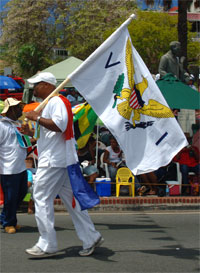 27 April 2006/Thursday/Charlotte Amalie, St. Thomas, U.S. Virgin Islands
27 April 2006/Thursday/Charlotte Amalie, St. Thomas, U.S. Virgin Islands
Dave and I went into shore at Great Harbour, Jost van Dyke at 0900 this
morning. Dave went to Customs to check out of the BVI. While he did that, I
took the camera and walked along the road following the shore. After we
finished taking photos, we walked to a small shop to buy bread. Next, we
went to the ice house to buy ice. Back at the beach, we stopped by Foxy's to
look around. The song that was playing when we came to Foxy's was "Band Of
The Year", the winning road march song we heard at Trinidad's Carnival.
There was a constant stream of power boats zooming in from the USVI (St.
John or St. Thomas) to check in to the BVI. Many of the people stopped at
Foxy's before heading out, so it was one busy place at 0930.
We took up the anchor and headed out of Great Harbour at 1100. We were
still discussing our plan. Should we stop in St. Thomas and sign in or
should we "yellow flag" the island (stop, fly the yellow flag, stay aboard
the boat). We weren't particularly interested in stopping at Charlotte
Amalie, as we remembered it to be a very busy harbor and mostly a stop for
shopping. The more we thought about it, we decided we didn't want to show up
in Culebra with a check out from the BVI and nothing from the USVI.
Our anchor went down in Charlotte Amalie Harbor at 1315. Amazingly, there
were not many cruising boats anchored in the harbor. We could see Yacht
Haven Marina is not open yet. The marina was damaged in Hurricane Marilyn.
The marina and a hotel were torn down and a fancy resort-marina complex is
being built. There were three huge cruise ships tied to the special cruise
ship dock. Dave went to Customs at the ferry dock to sign in to the USVI.
They told him it is a $5,000 fine for not checking in. Immigration wanted to
see David and I, so we had to go over with our passports. No problem.
The biggest news we heard from one of the Immigration officials was that
we were just in time for the two biggest days of St. Thomas' Carnival.
Tomorrow, Friday, is the Children's Carnival Parade at 1000. Saturday, the
big adult parade will start at 1000. We immediately changed our plan for
hurrying on to Culebra and decided to stay for Carnival. We walked around
downtown Charlotte Amalie from 1600 to 1700 before we stopped at Pizza Hut
for supper. The town looks very much like we remembered it, but some of our
old favorite shops were gone and another shop was in that space. I went into
several shops "just looking". Dave and David went into several camera shops
"just looking" and came out with a new camera. Dave has been researching
getting a new camera and knew exactly which one he was interested in. He
found the camera for a very good price at one of the duty free shops. He is
looking forward to using the new camera tomorrow to take photos at the
parade.
Several people we talked with told us very enthusiastically about
Carnival in St. Thomas. They are very proud of their Carnival Week and said
St. Thomas has the best Carnival after Trinidad in the Caribbean. We loved
Carnival in Trinidad, so we are really looking forward to seeing the parades
here.
About 2100 we discovered why there are so few boats anchored in the
harbor. There is a special Carnival Village set up on the road beside the
water. There are food and souvenir booths set up around a large stage. Every
night there is loud (really loud) live music from 2100 to 0200.
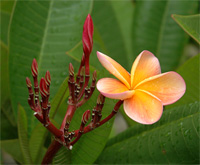 26 April 2006/Wednesday/Great Harbour, Jost van Dyke, British Virgin
Islands
26 April 2006/Wednesday/Great Harbour, Jost van Dyke, British Virgin
Islands
We let go of the mooring at Marina Cay this morning at 0735 and picked
up a mooring temporarily in Trellis Bay. At 0845 David and Sarah headed into
shore to take Sarah to the airport. The airport is a three minute walk from
the dinghy dock. I rode into shore with them and had a look around the shops
lining the shore. I didn't bring a camera in with me and once I was there, I
wished I had the camera. I took the dinghy back out to the boat to get the
camera and to see if Dave wanted to come in and look around. I returned to
shore with both Dave and the camera.
David joined us after Sarah had to go through security to the boarding
area. We went to the shop to pick up bread and ice. We were in the dinghy
headed out to the boat when Sarah's plane took off.
Back at the boat we let go of the mooring at 1230 and headed for Jost van
Dyke, the British Virgin Island that is farthest west. We arrived at Great
Harbour, Jost van Dyke at 1515. First David, then Dave took the kayak out
and had a look around the anchorage. Great Harbour is strip of several
businesses arranged along the shore. The small village is the largest
settlement on the island. This bay is known literally around the world
because it is the home of Foxy's. Foxy's Tamarind Bar and Grill is famous
for great beach parties, especially the one held on New Year's Eve. The
Foxhole, an extensive gift shop is next to Foxy's. We will definitely check
this place ot when we go in tomorrow morning to check out of the BVI.
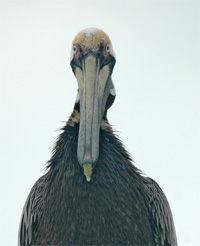 25 April 2006/Tuesday/Marina Cay, British Virgin Islands
25 April 2006/Tuesday/Marina Cay, British Virgin Islands
We all had a discussion first thing this morning about the pros and cons of
staying at Marina Cay today...or going to another anchorage. It was quickly
decided that we would stay here today. Sarah leaves tomorrow morning from
the airport on Beef Island. Marina Cay is within sight of Trellis Bay, Beef
Island.
Dave worked on the mail. He went through the mail Sarah brought to us
from Kentucky again, because he wanted to take care of some of the business
that needed a reply. He wanted to send the replies with Sarah. I was also
finishing organizing some things for Sarah to take to Kentucky and put in
the mail. It is hard to stop and take care of business when we are in such a
lovely place. I would much rather be out and about seeing and doing things.
David and Sarah went snorkeling. They saw a lobster. Later, they took the
kayak over to Trellis Bay and had a look around on shore. They said there is
a nice arts and craft shop there and a small market selling fresh bread. I
will take a look at them when we go over there tomorrow morning.
We have really enjoyed showing Sarah around and getting re-acquainted
with the British Virgin Islands this past week. We went to: 1) Trellis Bay,
Beef Island, 2) Bitter End Yacht Club, Virgin Gorda, 3) Setting Point,
Anegada, 4) St. Thomas Bay, Virgin Gorda, and 5) Marina Cay. We will be
going to Jost van Dyck, BVI, to check out on our way to St. Thomas.
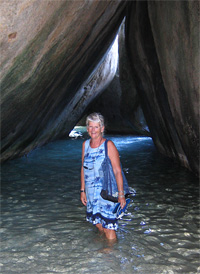 24 April 2006/Monday/Marina Cay, British Virgin Islands
24 April 2006/Monday/Marina Cay, British Virgin Islands
We took the dinghy into the marina dinghy dock this morning and took a taxi
to The Baths. Today, we took the video camera and the digital camera. When
you approach The Baths from the sea like they did yesterday, you do not have
to pay an entrance fee. We were dropped at the "top" of The Baths property
by the taxi. We were asked to pay $3.00/per person and we surely didn't mind
paying the money, because it goes for up-keep of the national park. We
walked down a well-maintained trail through a wooded area for 15-20 minutes
to reach the granite boulders at the edge of the ocean. Once at the beach,
we followed another trail leading through the "caves" and "hidden pools"
formed by boulders tumbled on top of each other. The national park has done
a good job of putting in wooden steps to make the trail easy to follow when
you have to climb up and over boulders. We went all the way to the end of
the trail at Devil's Beach. From there, you can return back to the upper
level near the park entrance by following a track that runs through an arid
area covered with multiple kinds of cacti. We got some good photos of
individual cactus plants.
After catching a taxi to return to Virgin Gorda Yacht Harbour, we stopped
by the store for fresh bread and ice. We went out to the boat at anchor in
the bay and got ready to leave for Marina Cay. The trip from St. Thomas Bay
at Virgin Gorda to Marina Cay near Trellis Bay on Beef Island took 50
minutes. We left at 1400 and picked up a Marina Cay mooring at 1450. Marina
Cay is a small islet with a reef on three sides, so there is good
snorkeling. There is a small hotel with six rooms and two restaurants on the
Cay. David and Sarah enjoyed kayaking around the cay in the clear blue
water.
Dave and I went into the dinghy dock and had a look round on the cay.
Dave got some more good flower photos in the gardens. We had a look at the
small white sand beach and could see the reef through the clear water. In
the late 1930's, Marina Cay was home to newlyweds Robb and Rodie White. Robb
White wrote a book, OUR VIRGIN ISLAND, about living on the cay. A movie was
made based on the book starring Sidney Poitier. Robb departed for WW II and
the island was uninhabited until a small hotel opened there in 1960. Today,
Marina Cay is a favorite stop for all the cruisers.
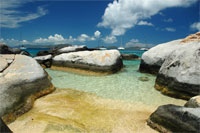 23 April 2006/Sunday/St. Thomas Bay, Virgin Gorda
23 April 2006/Sunday/St. Thomas Bay, Virgin Gorda
We dropped the mooring at Anegada and headed back to Virgin Gorda at 0800.
Our goal today was The Baths at the southwest tip of Virgin Gorda. We had a
lovely sunny day and an east wind, so we sailed there and arrived at 1140.
Today, The Baths is a national park complete with mooring buoys and the rule
"no anchoring at The Baths". The Baths are an unusual collection of huge
granite boulders lying at the edge of the sea. The problem is The Baths are
so popular, there are not enough buoys for all the boats coming there
everyday, so some boats have to anchor after the buoys are full. We anchored
out in 45 feet of water. There was a big swell coming in, so the boat was
rocking and rolling.
Dave, David, and Sarah went in the dinghy along the shore to take photos
and video. I stayed with the boat. When they came back to the boat to drop
off the cameras, they said they were going to go in and snorkel, but they
would have to leave the dinghy on a floating dinghy platform out from the
shore. No dinghies are allowed at the shore, plus Dave said the swell was so
bad, he wouldn't try to take a dinghy in there. I decided to stay on the
boat. When they came back after snorkeling, they said they didn't see many
fish and the undertow was quite strong. They did go on shore and walk
through the rocks all the way to Devil's Beach.
We moved the boat from The Baths to St. Thomas Bay, which is located
outside Virgin Gorda Yacht Harbour. This is the marina we stayed in three
nights ago. Today we anchored outside the entrance to the marina in a very
protected anchorage. Tomorrow, we are going to take our dinghy into the
dinghy dock at the Yacht Harbour and take a taxi or walk from Virgin Gorda
Yacht Harbor to The Baths. We will take the cameras and get photos while
walking inside the rocks. Dave and David said they were surprised to see
that although the boulders are huge, they are not quite as big as they
remembered them to be.
After cleaning up, David, Sarah, and I went into the Yacht Harbor in the
dinghy. I threw one load of clothes in the washer at the laundry while David
and Sarah took a walk around Spanishtown. There was a TV near the laundry
with CNN news turned on, so I got to see the latest news while I waited for
the washer to finish. The dryers didn't work well the other day, so we took
the clean clothes and hung them on the lifelines to dry. David and Sarah
said a lady driving by them stopped and asked them if they wanted a ride to
The Baths, because it is quite a walk. Nice. They thanked her for offering a
ride. We went to the grocery store to buy ice cream and strawberries because
today is Sarah's birthday. We ordered pizza at the The Bath and Turtle
restaurant. Good pizza and ice cream...we enjoyed celebrating Sarah's
birthday!
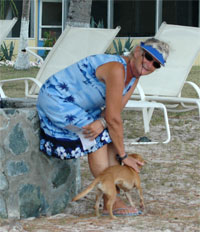 22 April 2006/Saturday/Setting Point, Anegada, British Virgin Islands
22 April 2006/Saturday/Setting Point, Anegada, British Virgin Islands
We left the Bitter End at 0830 this morning and headed north for Anegada.
Anegada is a coral and limestone island, unlike the volcanic islands usually
found in the Caribbean. Anegada is 11 miles long, half as wide, and its
highest point is 28 feet above sea level. You cannot see the island until
you are close enough to see the palm trees lining the beaches. It is a long
time between seeing the palm trees and actually seeing the flat island.
Anegada is famous for mile after mile of white sand beaches. Horseshoe Reef
extends 10 miles to the southeast and there are over 300 known wrecks on
that reef. Anegada is also famous for wreck diving.
The weather was a tad sunnier today with big cloud banks passing over
occasionally. We had no trouble getting to the island and following the
buoys inside the reef. There were at least 20 boats, mostly catamarans, on
buoys or anchored off Setting Point. We picked up a buoy because being on a
buoy spaces the boats around you better than when everyone anchors and picks
their own place. Some people anchor better than others. Also, we only had
2.5 feet of water under our keel. It is hard to know how much scope to let
out and to have enough room to let enough scope out.
On shore, we found it was a quiet, possibly rainy day. One of the locals
told us they have a lot of day-trippers who come from near--by islands, but
today no one comes. We have read that 180 people live on Anegada. David and
Sarah took off along the beach to walk to the north end of the island. Dave
and I headed inland to find the salt pond with flamingos. We walked for
about five minutes and came to The Purple Turtle shop. I stopped because I
wanted a t-shirt from Anegada now that I was finally there. I bought a shirt
that says "If found, return to Anegada" on the back. We walked 10-15 further
heading for the salt pond when the sky over the far side of the island
turned very dark with white roll clouds in front of the black clouds. We
decided this wasn't a good time to walk to the center of the island, so we
headed back to the beach where there were restaurants and a small store to
protection from the rain if it came to that.
Dave found lots of subjects for photos. There was a pelican in the water
just off the beach almost continuously diving for food. One brave seagull
would wait until the pelican had food in its pouch, then the seagull would
fly over and land on the pelican's back. He would hassle the pelican and try
to make it drop some food. The pelican would start paddling through the
water trying to "shake" the seagull off. It was very funny to see the
seagull riding on the pelican's back all over the bay. Dave got good
pictures of these two.
There was a group of 14 sand pipers. They were about the size of
half-grown chickens. They move up and down the beach at the edge of the
water. When one eats, they all eat. When one bathes, they all bathe. When
one preens, they all preen. We watched them for a long time trying to see
which bird ate, bathed, or preened first. Who was the leader of the group?
We never figured it out.
We would have liked to take a taxi ride and see the island, then do some
snorkeling on the other side of the island. The water on this side of the
island is clear, but the sand is so fine and powdery, the wave action stirs
up the sand and makes the water look milky. Everyone told us the water on
the other side of the island is crystal clear. This wasn't a good day for
touring or snorkeling. The rain was falling hard on the other side of the
island and we kept getting sprinkles from the closer side of the storm
clouds where we were.
 21 April 2006/Friday/Bitter End Yacht Club and Resort
21 April 2006/Friday/Bitter End Yacht Club and Resort
We dropped the line on the mooring at 0745 this morning and headed north and
a little east. Our goal is to go to Anegada, the most northerly island in
the British Virgin Islands. The weather today was cloudy and squally, so we
decided we would go half-way to Anegada and stop somewhere in North Sound.
North Sound, or Gorda Sound, is a large protected bay located at the north
end of Virgin Gorda. At 1005 we picked up a mooring at the Bitter End Yacht
Club. This resort is famous for the variety of water sports available to the
people who stay in their 77 beachfront villas or stay on chartered boats at
the dock.
The rain squalls kept coming and going all morning. Between rain showers,
David, Sarah, and I went into the dinghy dock and on shore to pay for the
mooring and check out the place. We immediately saw the fenced-in shark pen
complete with a large puffer fish and small stingray. Four small black-tip
sharks were swimming around. There was a lovely open-air restaurant and
reception building on the beach. We walked past buildings that were the
sailing school, water sports hut, the Emporium selling groceries and fresh
bread, a Pub for drinks and snacks, windsurfing school, etc. It started to
rain again, so we went back to the boat to fix lunch.
After lunch, we got a break in the weather. David and Sarah went
snorkeling and paddling the kayak. Dave and I went into shore with the
camera to take photos of the sharks, stingray, and puffer fish. When we
finished doing that, we walked along the path that leads to the villas and
swimming pool at the far end of the beach. Lovely gardens were planted with
tropical plants all along the path and most of the plants were in bloom.
Dave got really good photos of some flowers and cactus plants we hadn't seen
before. The remaining raindrops on the flower petals and leaves added
interest to the photos.
We had an amazing experience as we were looking at a large group of
spider lilies. I told Dave I thought I saw something move. We looked closer
expecting to see a hummingbird or insect, and the flower moved again! We
watched the closed bud of the spider lily open. First it was two white petal
parts, then both of those parts split into three petals each, so six slim
white petals curved out. Inside, there was a clump of six orange stamens
that separated from each other. A lady came along while Dave and I were
standing there watching the flower open. She heard us say, "Look, it is
moving" and wondered what we were watching. She was surprised when we said
we were watching a flower open. She joined us and saw a second flower open.
A couple from a catamaran on a neighboring mooring stopped by the boat to
ask about our wind generators. We asked them about getting into Anegada and
they told us it was marked with buoys these days and charter boats were
allowed to go there now. When we lived in Puerto Rico long ago, going to
Anegada was something special. The island is surrounded by big reefs and
lots of shipwrecks. You had to do very careful navigation to get through the
passage in the reef. We didn't trust our anchor for those shallow waters, so
we never went to Anegada. Thus, we have always wanted to go to Anegada.
Tomorrow is the day.
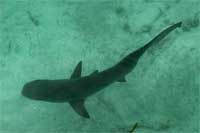 20 April 2006/Thursday/Trellis Bay, Beef Island, British Virgin Islands
20 April 2006/Thursday/Trellis Bay, Beef Island, British Virgin Islands
After the live music at the reataurant ended at midnight, we had a quiet
night in the marina. Many of the boats at the dock to not have anyone on
board. A lot of the charter boats are now that floating quiety at the dock
now that high season is over. We went to the fuel dock and filled our tanks
with diesel and filled the dinghy fuel jug with gasoline. We had washed the
boat down with fresh water and filled the water tanks while we were in the
slip. Water costs 10 cents per gallon.
We pulled away from the fuel dock at 1030 and tied on to a mooring in
Trellis Bay at 1135. Now, that is easy cruising! Trellis Bay is located on
the north shore of Beef Island. Beef Island is connected by a small bridge
to the east end of Tortola Island. The airport is located on Beef Island, so
we anchored in Trellis Bay where David could literally walk to the airport
to meet Sarah when her airplane arrived at 1750 today. Dave and I didn't go
exploring today because we knew we will be returning to this bay when Sarah
departs for the States on 26 April. We took afternoon naps to catch up on
the sleep we missed when we did the overnight sail from St. Martin/Sint
Maarten to the BVI.
There is a small cay named Bellamy Cay in the middle of Trellis Bay. The
Last Resort used to include a hotel, but today the Last Resort is a
restaurant. On shore, there are a number of shops and cafes lining the
water's edge. The guide book says many artists have studios here where they
work as well as display their work for sale. Aragorn's Studio is the home of
Gli Gli, the largest Carib Indian dugout sailing canoe in the Caribbean. We
heard about this canoe on the island of Dominica where it was hand-made. The
canoe made a voyage from Dominica to Venezuela and north again. We are
curious to see the canoe and the documentary video that was made about the
canoe, the voyage, and the men who built the boat. We read in the newspaper
that the canoe is in Antigua for Classic Boat Week right now, so we are
hoping to see it when we return to Trellis Bay.
Sarah arrived on time from San Juan, Puerto Rico. We watched her plane
come in over the bay. David took the dinghy to the dock and walked to the
airport to meet her.
 19 April 2006/Wednesday/Virgin Gorda Yacht Harbor, Spanishtown, Virgin
Gorda
19 April 2006/Wednesday/Virgin Gorda Yacht Harbor, Spanishtown, Virgin
Gorda
We had a great trip coming here. I told described the beauty of the night
yesterday. We all remarked this morning that last night was the best sleep
we have had in days. The anchorages we have been in recently have been
rather bouncy, so we sleep at night, but not always peacefully. Last night
we motored all night, but the smoothness of the sea meant the boat was
hardly moving up and down.
I woke up at 0740 this morning and there was Virgin Gorda...and Ginger
Island, Cooper Island, Salt Island, Peter Island, and Norman Island on the
south side of Sir Francis Drake Channel. Tortola is on the other side of the
channel. It was like seeing old friends. Dave and I reckon we were last here
in the summer of 1992 when we chartered a Privilege 39 to see if we would
like it. We came to the BVI by boat several times from Puerto Rico, so we
know these islands and anchorages well. We came around Round Island and
headed north past The Baths. This is the collection of huge boulders lying
at the edge of the sea. Now, there are mooring balls and a floating dinghy
dock. The Baths have been declared a National Park, so everyone pays a fee
to go there. We did not stop today, because we have to sign into the BVI
before we can stop anywhere. We will be going to spend time at the Baths in
a few days.
We called Virgin Gorda Yacht Harbor and asked for a slip for one night.
They said they had one, so we tied at the marina. Dave went immediately to
Customs and was gone quite a long time. There was one charter boat with 43
passengers to be checked in and another charter boat with 28 passengers to
check in, so he had to wait until Customs was done with those two groups.
When Dave came back and told us we were no legal, he and I walked over to
the marina office to sign in and pay for the slip. Next, we went to the
shopping area located at the marina to see what is available here. Our first
discovery was a launderette. We are looking forward to getting some laundry
done. We went into the small, but well-stocked grocery store to find
something interesting for lunch. Dave chose pork chops.
After lunch, we started using the marina facilities. Dave and David put
the dinghy engine on the dinghy, cleared the water jugs out of the cockpit,
and used fresh water from the dock to wash down the deck and cockpit area.
They filled the water tank so it can settle overnight, then we will top up
the water tomorrow morning. Fuel is available at the fuel dock, so we will
stop there on our way out tomorrow morning. I did some hand-washing and hung
it out to dry, then gathered the rest of the laundry to take it to the
launderette. You can do the laundry yourself or pay a lady to do it. I chose
to do the laundry myself. I had to buy tokens from the lady running the
place, then she put the tokens into the machines. She was very efficient and
helpful. Unfortunately, I couldn't get three dryers at the same time after I
did three loads of washing. It took a very long time to finish drying all
the clothes. As usual, some dryers were better than others. While I waited
for dryers, Dave and David continued to clean-up the boat, so she is looking
better than she has in a long time right now.
David paddled the kayak down to The Baths and came back really excited
about going snorkeling and exploring among the rocks. He thought maybe he
remembered the boulders as bigger than they really are because he was young
when he played there. Today, he was pleased to discover The Baths were just
as beautiful and magical as he remembered them to be. He is looking forward
to sharing The Baths with Sarah after she arrives for a visit on the 20th.
In fact, we will be moving from Virgin Gorda to Trellis Bay at Beef Island
tomorrow. Trellis Bay is within walking distance of the airport where Sarah
will arrive tomorrow evening.
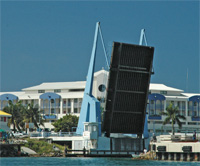 18 April 2006/Tuesday/sailing overnight from St. Martin/Sint Maarten to
Virgin Gorda, BVI
18 April 2006/Tuesday/sailing overnight from St. Martin/Sint Maarten to
Virgin Gorda, BVI
Dave and I got in the dinghy at 0845 this morning and started across the
Marigot anchorage to the inlet that connects with the Simpson Bay Lagoon.
This huge lagoon can be entered by going under a bridge on either the French
side or the Dutch side. The inlets are both crossed by swinging bridges that
open to allow sailboats to go in and out of the lagoon at schedules times
each day. We heard good things about being inside the lagoon, but we decided
since we are going to be here such a short time, we did not want to spend
time going in and out of the lagoon on a schedule. There are several big
yacht chandleries located at the edge of the lagoon. They have dinghy docks
beside their stores, so our goal was to check out Budget Marine and Island
Water World. Fortunately, we don't need anything, but we are looking for a
couple of guide books.
To make a long story short, it took us 35 minutes in the dinghy to get to
Budget Marine. I had no idea it was that far! The dinghy dock at Budget
Marine was packed with dinghies and we were lucky to get a spot because
someone was just leaving. We checked out the chandleries, then made the
return trip across the lagoon. We stopped at a dinghy dock nearest to the
U.S. Supermarket where we were yesterday. I stayed with the dinghy and Dave
walked to the store to pick up some pop.
Back at the boat, we left the two small bags we had from the chandleries
and the pop. We picked up Elvin and headed into the Marigot dinghy dock. I
read in the guidebook there is a Match grocery store on the edge of town
that is within walking distance from the waterfront. Dave and I walked for
about 15 minutes and arrived at the collection of shops with Match in the
middle. This was my last chance to shop in a French grocery store. I always
enjoy seeing what is on the shelves and the Dijon mustard is always a good
price! We mostly bought fresh fruit and vegetables. The tomatoes we have
eaten in the islands have been really delicious. The cucumbers are very fat
and full of rather large seeds. I prefer the Lebanese cucumbers that are
long and thin with almost no seeds, but haven't seen that kind since we left
the Med. We bought a roti chicken on the way back to the boat.
Dave dropped me and the groceries off at the boat and took the boat
papers to Customs to check out of St. Martin/Sint Maarten. He did not come
back for almost two hours. Checking in here went so smoothly and took so
little time, David and I couldn't imagine what happened. While we waited,
David dived in the water with his mask and snorkel on and cleaned the bottom
of the boat. I got in the water to cool down and just enjoy being in the
beautiful aqua water.
Dave finally returned and we were checked out. It was a close one. Turns
out people from seven boats showed up to sign out today and the Customs
official wasn't there. Evidently, the Customs person gave himself the day
off after the 3-4 day holiday over Easter. Someone at a near-by desk called
the Customs official and eventually he did show up. He couldn't believe all
these people wanted to check out...now? He told everyone he did not have
enough forms for everyone, so they could come back tomorrow. Dave said the
group wanted to sign out today and did not want to sign out tomorrow, so he
and another man went to a shop that does xerox copies and made enough copies
so each boat would have the four pieces of paper they needed to fill out.
The Customs official was not helpful, but when they showed up with papers
for everyone, he did go ahead and do his job, so people could legally leave.
One Italian man had provisioned his boat in the morning and he was ready to
head trans-Atlantic...today!
We ate a late lunch, cleaned up the boat for being at sea, then left
about 1730. There was almost no wind and it was a good thing because the
northwest wind direction was directly on the nose for us. We sailed off into
the sunset (literally) and saw a green flash. The night sky was clear and
full of stars. I was on watch from 2000 to 0030 and saw several ships and
sailboats. Several cruise ships were moving at 6-7 knots toward tomorrow's
destination. It is cheaper for them to be at sea at night rather than pay
docking fees like they do all day. It wasn't hard to stay awake with so much
traffic coming and going. The lights were easy to see in the darkness. I
listened to the "Revival In Belfast" album and John Denver singing songs
about the beauty of the earth on the I-Pod. I was already thankful for the
beauty of the night sky reflected in the mirror of the calm ocean and the
silvery ribbons of phosphorescence coming off the bow slicing through the
water. The orange half moon rising about 2300 was so bright, the stars
became muted in the night sky.
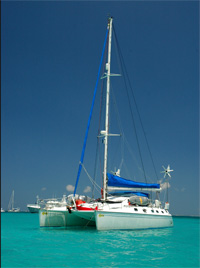 17 April 2006/Monday/Baie de Marigot, Saint Martin (French)
17 April 2006/Monday/Baie de Marigot, Saint Martin (French)
Today was a very quiet day in Marigot. Almost all of the shops, restaurants,
etc., were closed for Easter Monday. There wasn't nearly as much traffic on
the roads. All of this we observed from the boat in the anchorage.
Dave and I decided to go into shore and take a walk to get some exercise
by walking along the road closest to the shore. There aren't always nice
wide sidewalks to walk on, so sometimes we were actually walking on dirt
beside the road. The fact that the shops and restaurants were closed seemed
to mean there was less traffic on the roads. We walked along past huge
hotels that were only partially full at this time of year. Even though it is
a holiday, it is getting warm enough other places that people aren't as
drawn to the Tropics at this time of year like they are in the winter when
it is cold where they live. Someone here told us "the season" ends by the
end of April in St. Martin/Sint Maarten and some hotels, shops, and
restaurants will close from April to October.
Dave and I walked until we came to a store called "U.S. Supermarket". We
couldn't pass that one up, so went in to take a look. This was a small store
with lots of products in it from Europe and North America. We bought a few
odds and ends, but not much, because we didn't want to carry much back with
us. We left the store and walked into the hallway that connects a few small
shops together. As we looked outside, it was raining hard. There was a kiosk
selling magazines and booklets right there, so we passed the time looking at
the books until the rain stopped.
We are still planning to leave tomorrow afternoon for Virgin Gorda, BVI.
I have a list of things I would like to do before we leave here, so we are
going to make an early start tomorrow to see how many of them we can do
before we leave.
 16 April 2006/Sunday/Baie de Marigot, St. Martin (French)
16 April 2006/Sunday/Baie de Marigot, St. Martin (French)
As we had hoped, the wind came around to the east/north east during the
night. The "ride" here in the Baie was quite comfortable. Today, being
Easter, most shops were closed by law...excepting shops selling bread and
milk products and tourist goods were allowed to be open because the cruise
ships are still coming today and some of the 6,000 sailors on the USS GEORGE
WASHINGTON will be on shore today. We read this information in the newspaper
that is printed in English on this French and Dutch island. Everyone in the
shops and restaurants seems to speak English, besides French and Dutch, and
maybe Spanish and German. There are a large number of European yachts at
anchor here.
Dave and David climbed the hill over-looking the bay and stood by the
ruins of Fort Louis to take photos and video. Fort Louis was constructed in
1767 by order of French King Louis XVI to protect Marigot from British and
Dutch pirates. A French flag flies high above the ruins today. I didn't make
the climb, but they said it only took about 15 minutes to climb up the hill.
The view from up there was excellent. They could see the islands of Saba,
St. Eustatia, Anguilla, and St. Barts in the distance. I asked them to see
if they could spot the Match Supermarche (a large supermarket)at the edge of
Marigot, because the guidebook says it is close enough to the waterfront to
walk to the supermarket. They did see Match when they were looking over the
town. These intrepid explorers managed to find fresh baguettes and a roti
chicken for lunch. What a treat! I added a Greek salad and we had a
delicious meal.
After lunch, David took the kayak and paddled his way around this bay.
After he successfully maneuvered upwind for awhile, he went through the
small canal and under the bridge to enter the inner Simpson Bay Lagoon. This
large lagoon is completely enclosed by land with a French opening bridge and
a Dutch swinging bridge that open on regular schedules. We are free to take
our boat into the Lagoon where the water is very calm. This "outside"
anchorage is suiting us just fine for the short time we will be here.
David and I got ready to go in to shore at 1730 to listen to the Easter
Concert in the Open Air Theater near the waterfront. Just as we started to
get in the dinghy, big black storm clouds started moving in from the
north/north-east, a boat behind us was dragging, and it looked like it was
going to rain hard. We decided we didn't want to be out in the dinghy or on
shore in a rain storm. We stood out on deck and could hear the concert begin
with a choir singing songs from the CD, "Revival In Belfast". Since we know
all those songs well, we knew the music immediately. We have heard those
songs sung literally all around the world.
Tuesday morning the marine shops will reopen and we have a few stops we
want to make. We are going to check out the Budget Marine Chandlery, Inter
Island Water World Chandlery, and I want to go to Match. Since we are
leaving on an overnight passage to Virgin Gorda late Tuesday afternoon, we
have a limited time to go to these shops Tuesday morning before we check out
to leave. I am sorry we have to leave so soon, because we really do like St.
Martin/Sint Maarten, what little we have seen of it. If we had more time, we
would definitely try to see more of the island. Even though the island is
small, there are quite a lot of places of natural beauty to see. A wide
variety of species of birds gather around the salt ponds in large numbers.
There are special areas for seeing monkeys and butterflies. Guess we will
have to come back sometime...
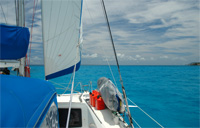 15 April 2006/Saturday/Baie de Marigot, St. Martin (French)
15 April 2006/Saturday/Baie de Marigot, St. Martin (French)
There were at least 50 boats anchored in Anse de Colombier last night,
sheltering from the south wind. This morning, the north-northwest wind was
blowing right into the bay and we were all bow-to the opening of the bay and
bouncing with each new swell. We left Anse de Colombier, St. Barts at 0840
and motored straight into the swell and wind. Fortunately, the winds were
only 12-15 knots, so the swell had not built up yet. Dave kept trying to put
sails up, but the sails couldn't catch the wind. We could clearly see St.
Martin/Sint Maarten from St. Barts, because the rains yesterday cleaned the
ash and dust out of the air.
St. Martin/Sint Maarten is one of the most interesting islands in the
Caribbean because this small island (7 miles long and about half as wide) is
roughly divided from west to east with the French owning the top half with
the capital, Marigot, and the Dutch owning the bottom half with the capital,
Philipsburg. The guide book says the Dutch wanted to own the salt ponds in
the south and the French wanted land for growing tobacco and sugar, so they
took the north. Today, the whole island is a duty-free cruise ship Mecca and
is quickly becoming the mega-yacht capital of the Caribbean.
We came along the southern side and the western side of St. Martin/Sint
Maarten. There are beautiful beaches backed by dramatic towering cliffs and
rocks. These were some of the most picturesque beaches we have seen. There
are pockets of tourist accommodation, but there were still beaches without
hotels built on them, too. We passed the large open bay at Philipsburg and
several ferries were busy going back and forth from the harbor to the USS
George Washington, a U.S. Navy aircraft carrier that is spending a four-day
holiday here from yesterday to next Monday. As we entered Baie de Marigot,
we easily found a place among all the boats to anchor, because the bay is
quite large. The water is fairly shallow with a white sand bottom, so the
aqua color of the water is amazing. The anchorage is right off the town of
Marigot with a very nice dinghy dock provided right by the outdoor market.
After lunch, we put the dinghy in the water and went to sign in to St.
Martin. We locked up the dinghy and walked about 30 steps to the ferry
terminal. The Customs officials were there checking out passengers from St.
Martin before they boarded the inter-island ferries. Dave told one of the
officials we wanted to check in and he handed us two papers. We sat on
concrete blocks outside the terminal and filled in the papers. Dave returned
the papers and the man said, "Thank you". That was that. We walked around
town and had a look. Over half of the shops were open because cruise ships
and the aircraft carrier were in today. Although most of the people first
arrive at the dock in Philipsburg, usually the tourists manage to see both
sides of the island before they leave. We took a quick walk through the
beautifully dsigned West Indies Mall building. If you don't have a few extra
hundreds or thousands of dollars to spend, there isn't much you can afford
in the shops. The open-air theater is right in the middle of the waterfront
area. We read in the paper they are having an Easter concert there tomorrow
night, so we plan to go.
The wind continued to blow into the bay from the north-northwest, but we
are guessing it will come around to its normal direction, out of the east,
by tomorrow morning. If and when the wind returns to the east, we are going
to have a very protected anchorage here. We plan to stay here through
Tuesday afternoon when we will be leaving on an overnight passage to Vigin
Gorda, BVI.
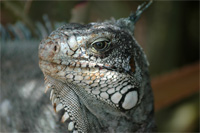 14 April 2006/Friday/Anse de Colombier, St. Barts
14 April 2006/Friday/Anse de Colombier, St. Barts
After quite a bouncy night with the south wind and swell coming right into
the Basseterre, St. Kitts, anchorage, we were glad to wake up this morning
and head north. The boat moved constantly all night, so it felt like we were
on passage. Fortunately, the wind was only blowing around 10 knots, so the
swells were constant, but not large.
We took the anchor up at 0615 just as the sun was rising over the hills
on the south end of St. Kitts. Dave took some photos of QUEST at anchor,
then we headed to the north end of St. Kitts thinking we would go 22 miles
northwest to Oranje Baai, St. Eustatia (Statia). We have slowly been heading
northwest from Guadeoupe to Monserrat to Nevis to St. Kitts. St. Eustatia is
normally the next logical stop on this path or Saba, which is 17 miles
further. We had already decided to skip St. Barthelemy (St. Barts) because
we would have to beat to the northeast to get there. All of these plans were
based on what is usually happening with the winds. Today, we had the unusual
south wind with us again, which meant we could leave the north end of St.
Kitts and easily go downwind to St. Barts. We ended up going much farther
today than we planned and ended up at a totally different destination than
we originally chose.
St. Barts was used by French pirates as a base in the 1600's. In the late
1700's, France traded St. Barts to Sweden in exchange for trading rights in
Gothenburg. France bought St. Barts back in 1878 and it remains a duty free
port of France today. Development of the island came slowly because there is
not enough fresh to support a settlement. Today, a desalination plant,
improved rain water catchment systems, and bottled water have solved that
problem. St. Barts is famous as a favorite island of the rich and famous. We
were told it is the "in" thing to spend Christmas at St. Barts, the Riviera
of the Caribbean.
We arrived off Gustavia, St. Barts, in the middle of a huge rain squall
at 1345. The anchorage at Gustavia was quite crowded already and with south
winds and swell, the boats were bouncing around a lot. Besides the weather
and sea conditions, today is Good Friday and everything in town is
officially closed. We read about the Good Friday and Easter Monday holidays
in the newspaper down island. We decided to keep going to the north end of
St. Barts where there is a large bay with better protection from southerly
winds. Anse de Colombier is a large bay that was already over half-full of
boats ranging from pocket cruisers to mega yachts anchored inside. We found
a spot and got settled in before the next squalls hit. By sundown, the bay
was pretty tightly packed with boats. This bay was originally owned by the
Rockefellers who built a house over-looking the palm-lined beach here. There
are no roads accessing the bay, so the only way to get here is by boat or a
long hike.
The squall lines kept coming about every hour. The rain washed the
Monserrat volcanic ash off the hast and rigging, etc., and all the dark gray
ash mixed with water was making a mess in our cockpit. Between squalls, Dave
washed down the cockpit with saltwater, then let the rain do the rinsing. We
will still give the boat a good wash down when we get to a marina in Virgin
Gorda for an overnight stop, but we were glad to get the worst of the ash
off today. We can see St. Martin/Sint Maarten from here! Our next stop is
only 15 miles away.
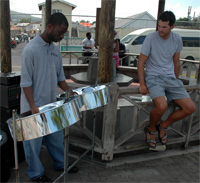 13 April 2006/Thursday/Basseterre, St. Christopher (St. Kitts)
13 April 2006/Thursday/Basseterre, St. Christopher (St. Kitts)
Dave and I went into Charlestown, Nevis, this morning to check out and pick
up some ice. As we got to the dinghy dock, we heard live steel pan music
coming from the dock. There were two smaller cruise ships (the ones that
look like pirate ships and "shoot" at each other) and a larger cruise ship
in today. The music was to welcome everyone to Nevis. Dave and I immediately
recognized the drums the man was playing were double tenor pans like the
ones David bought in Trinidad. I got out of the dinghy and Dave went back
out to the boat to tell David about the live pan music and bring him in to
hear it. David came in and got to talk to the man playing the pans. He was
playing melody on the pans using CD's with background music to fill in the
other parts.
While I waited for Dave and David to come to shore, I walked to the
grocery store to return the bag of salted fish. When I walked in both of the
clerks started talking to me. I asked them if they missed their fish and
they said they did. I told them I didn't discover the fish until after dark
last night and it was too late for us to return it then. They told me the
store was open until 2000 last night. I told them we don't go around in the
dinghy long distances after dark if we can help it. Anyway, they finally
said, "Thank you" and seemed please I brought their fish back.
After listening to several steel pan songs, Dave and I went into the
gardens at the Cotton Ginery Mall. Most of the shrubs and trees are
flowering at this time of the year and the colorful display was amazing.
Dave took photos for a long time. We must have found at least 15 different
kinds of flowers to photograph. The hummingbirds and butterflies were
fluttering around the blooms, but they are hard to catch in a photo.
We decided to go ahead and check out in Nevis and not try to go to
Customs in St. Kitts. The wind has been blowing all day from the south,
which is most unusual. This makes the swell go straight into the open
roadstead at Basseterre. Fortunately, the winds are light, so the swell
isn't too high. W
After lunch we decided to move over to Basseterre, because it is ten
miles closer to our next destination, St. Eustatia (Statia). We took up the
anchor just before 1400. It took 21/2 hours to sail over to Basseterre. We
saw seven other boats anchored off the west side of St. Kitts far from town.
We anchored with two other boats off the commercial port to the east of
town. We couldn't believe our eyes! One of the boats was QUEST! This was the
South African QUEST we traveled across the Pacific with in 1995. We saw her
last in Marmaris, Turkey, at a marina. Dave and David went over to talk to
the people on board. They bought the boat in Turkey. They are in the process
of moving it from Turkey to Alaska, where they live. Small, small world.
To make it even funnier...before they went over to QUEST (located 50
yards away from us), Dave tried to call them on the VHF. Someone answered
from far away and kept saying, "I can hardly hear you". When Dave went to a
clearer channel with the "faraway QUEST", it turned out there was a second
QUEST several miles away from us and those people were from Montpelier,
Vermont. Dave explained there are at least two boats with the same name in
the area.
We plan to move north and west early tomorrow morning, heading for St.
Eustatia.
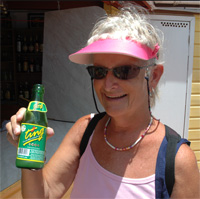 12 April 2006/Wednesday/Charlestown, Nevis
12 April 2006/Wednesday/Charlestown, Nevis
We decided to not move the boat today and stay anchored off this beautiful
beach for the day. After breakfast, we took the dinghy into town to get some
groceries. We went to a store called Best Buy and were amazed at the USA
products we found for sale there. We mostly bought pop, cereal, and UHT
milk. Our best discovery was frozen Freschetta pizzas. David recommended
this brand. Dave and I have heard of them and had one or two so long ago we
don't remember when that was. We checked out, Dave paid the clerk while I
bagged the loose groceries and David loaded Elvin with the pop and UHT milk.
We stopped at another shop to buy a bag of ice, then went straight to the
dinghy and out to the boat.
Once at the boat, I started the oven to bake the pizza and I put
groceries away while we waited for the pizza to cook. I thought all of the
groceries were put away and didn't think any more about it. Around 1900 last
night, I was making popcorn and suddenly wondered where the four bags of
popcorn I bought this morning had gotten to. I started looking and noticed
two grocery bags sitting under the navigation table. I looked in one and
there was the popcorn. I moved the other bag and it was heavy. I opened the
full bag and couldn't imagine what in the world I was looking at. There were
white rectangles of something heavy and hard stuffed in the bag. A closer
look...and smell...and we immediately realized we had picked up a bag of
salted cod fish at the store when we were packing up our groceries. Salted
fish is a very popular staple in the Caribbean and we have seen it (but, not
bought any) at every island we have gone to. The fish in the bag was worth
roughly $30 USD. We retied the top of the bag and set it in the cockpit for
the night.
Dave and David jumped in the water after lunch and gave the bottom a
quick rub down. They were so impressed with how much difference in speed
having a clean bottom made, they want to keep the bottom really clean, so we
can keep moving well. Besides helping us move through the water, the boat
looks a lot better when the bottom is clean. It looks like we care.
Dave took his camera in the dinghy and chased down some pelicans when
they were fishing. He got some really good pictures of the pelicans as they
were diving straight into the water. We were amazed how graceful these birds
seem in flight, because they have very boxy bodies and stubby tails. Their
wings are exceptionally long and strong. There are a lot of sea turtles in
the water around where we were anchored, but they pop up, then disappear too
quickly to get good photos.
We watched a movie and had popcorn in the evening. We didn't have any
more rain today. After the hard rain last night, I think the air itself was
washed clean. This was one of the brightest, clearest days we have seen in a
long time.
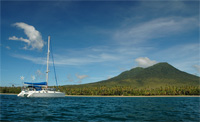 11 April 2006/Tuesday/Charlestown, Nevis
11 April 2006/Tuesday/Charlestown, Nevis
We had an uneventful night anchored at Little Bay, Monserrat. The anchorage
offered some protection from the wind and swell, but the wind still came in
blasts off the mountains and here were quite a few boats anchored in a small
space by sundown. The wind whipped around one way, then another. A couple of
the boats had to move, because they ended up too close to another boat. Once
again, we were grateful to have a beugel anchor. We keep an eye on our
position and that of other boats, but with the beugel down, we don't have to
worry about dragging.
We did not get off the boat at Monserrat. We reckoned sailing by the live
volcano gave us a much better view than a car ride to a distant observation
point outside the exclusion zone, so we didn't go on an official tour. It
was sobering to see the area where the town of Plymouth used to exist along
with a lava-covered golf course, empty beach hotels, etc. The Caribbean
islands all count on tourism for the largest part of their economy these
days, so Monserrat must be suffering from the lack of tourist income as well
as missing the ex-pat dollars and pounds that came in from people building
up-market holiday homes on the island. I wonder if the people who did stay
on the island wake up every morning and the first thing they do is look
south to the sky above the volcano to see what it is doing today. I know
that is the first thing I did.
The anchor was up at 0650 and we sailed mostly downwind or with the wind
on the stern quarter toward Nevis, 36 miles away. To the east of Monserrat
we could see Antigua. We headed west and a little north. About halfway
between Monserrat and Nevis is literally the peak of a mountain sticking out
of the water. This mini-island looks like a huge rock. It is one mile long
and almost 1,000 feet high. Close to the rock island we could see that this
was the top of a volcano and sometime in the distant past, one whole side
came off. This rock island is named Redonda. This rock island was claimed by
the British in 1872 and they annexed it as part of Antigua. There is no
anchorage and getting on the island is difficult because all of the sides
are steep-to. We read that phosphates were discovered here in 1865 and
mining began. Equipment for the 100 personnel who worked the mine was raised
on a two-bucket cable that went up and down balanced by seawater that was
pumped into a reservoir at the top. Phosphate production stopped in 1914 and
the lease ran out in 1930. In 1978, an independent Antigua set up a post
office on the rock island and issued stamps to commemorate 100 years of
phosphate mining. This enterprise was abandoned one year later.
This rock island also has a king. In 1865 Matthew Dowdy Shiell, an Irish-Monserrat
merchant, had a son after eight daughters. He wanted to give his son a
kingdom, so he claimed Redonda. In 1850 the father, son, and the Bishop of
Antigua made a day trip to the rock island. The son, M.P., was declared King
Filipe I of Redonda. M.P. Sheil (minus an "l") moved to England and became a
Gothic romance and science fiction author of some renown. Using his
connections as a writer to approach the British government, he constantly
sought to get recognition as King Filipe I of Redonda. M.P. died in 1947
after passing his crown to a writer named John Galsworth, who became King
Juan I. This man tried unsuccessfully to sell the kingdom. He died in 1970
after passing the crown to Jon Wynne-Tyson, who became King Juan II. This
man actually went to the rock island with a group of friends to plant a flag
on the top of the island in 1979. This man abdicated his role as king in
1998 and presently Robert Williamson, a writer and artist who lives in
Antigua, is King Robert. An annual literary prize is awarded by King Robert
and an inter-island committee.
We arrived at the southern end of Nevis around 1100. There is a volcano
at the end of the island that tapers down to flat land. As we were watching,
we could suddenly see billowing smoke covering a large area of land at the
edge of the sea. We thought the volcano was spitting out steam and ash.
Later, we could smell burning grass and decided this was a huge grass fire.
This theory turned out to be the correct one. The southern end of Nevis was
a little dry with sparse settlements dotting the island. We passed the
commercial port area and thought everything was tidy and neat, but not
different from all the other islands. We came to Charlestown, and saw a very
colorful, pleasant small town sitting at the edge of the blue water. Just
past Charlestown is the anchorage and it turned out to be one of the most
beautiful we have ever seen! What a surprise! Pinney's Beach is a sweeping
light beige beach lined with rows of palm trees. It looks just like a poster
or postcard for the perfect island beach. Truly beautiful. Mount Nevis rises
above the palm trees behind the beach. The top of the mountain reaches up
into the clouds and adds another "island touch" to the perfection of the
picture. We had no idea Nevis was such a pretty island.
Dave and I went into the dinghy dock right in front of the town. We found
the tourist information office and they told us where Customs was located.
Up the stairs and back in a corner was a small office that we entered
shortly before closing time. The officials were efficient and we were signed
into Nevis and had a cruising permit to move on to St. Christopher (St.
Kitts) and check out of St Kitts-Nevis in Basseterre, St. Kitts. We walked
to the police station to get our passports stamped. On the way through town,
we checked out a couple of small grocery stores and the ice cream shop. The
chocolate ice cream tasted like a Frosty. We will go back tomorrow and bring
Elvin so he can carry heavy things like UHT milk and pop. We stopped at a
small bookshop and found a basic book on Caribbean flowering plants. Dave
has taken some beautiful photos of flowering plants and bushes, so we wanted
to match the names to the photos.
Back at the boat we enjoyed the anchorage as the water reflected the
setting sun spreading pastel colors across the sky. Pinney's Beach is one of
the prettiest anchorages we have stopped at.
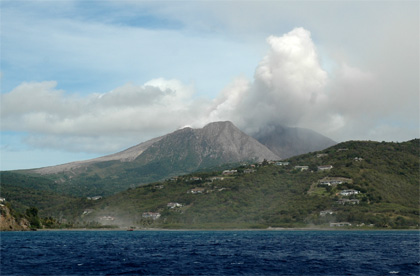 10 April 2006/Monday/Little Bay, Monserrat
10 April 2006/Monday/Little Bay, Monserrat
The sun rose and was shining on the anchorage when we woke up this morning.
We went into the village at 0800 this morning to see if the Customs man was
in his office. He was and we were able to check out of Guadeloupe in less
than ten minutes. Everything went smoothly. We walked back to the village
and stopped for baguettes, then straight in the dinghy and out to the boat.
We were taking up the anchor at 0850. As we moved away from the bay, we
could look back and see rain clouds coming up and over the mountain tops,
blocking out the sun, and pouring rain on the village and boats at anchor.
No wonder there was such lush greenery everywhere we looked.
We had a good sail for a few hours covering the 20+ miles from Guadeloupe
to Monserrat. We were moving at 7.5+ knots under sail, thankful again for a
clean bottom. What a difference that makes! We could see the active volcano
at the south end of Monserrat from several miles away. There was a
constantly changing white cloud and another beige cloud coming out of the
top. This volcano, the Soufri`ere Hills Volcano (3,180 ft) erupted 18 July
1995 after lying dormant for over 400 years. The capital and only proper
town on the island, Plymouth, was located at the foot of the volcano. Today,
Plymouth has been abandoned after a river of lava and several feet of ash
covered parts of the town. Farmers continued to farm the ash-enriched land
until a superheated pyroclastic flow wiped out the remainder of Plymouth on
25 June 1997. The volcano erupted still again in July 2003.
On 18 July 1995, there were 11,000 people living on Monserrat. Today,
only a third of the population is still here. The people here are living on
the northern half of the island. An exclusion zone has been enforced that
determines which areas of land and sea are at risk if there is another
eruption. The exclusion zone goes out two miles from the island. All boats
are supposed to be at least two miles off shore from the southern end of
Monserrat. We stayed three miles off shore and watched another boat sail
right into a big ash cloud. They turned around and came right back out. Not
only would it be hard to breathe (and not healthy), we kept thinking about
the mess the ash would make on the boat.
Tonight we are anchored in Little Bay with 10 other boats. The best
anchorage on the island is in the exclusion zone, so we cannot use it. This
anchorage is where the fishermen leave their fishing boats. We do have some
protection in here, but the wind blasting down off the mountains reminds us
again how glad we are to have a beugel anchor holding us. We just hope
everyone else's anchor holds them as well as our anchor is holding us. I
think all of these boats will spend the night here, then head out in the
morning. We will be going to Nevis tomorrow.
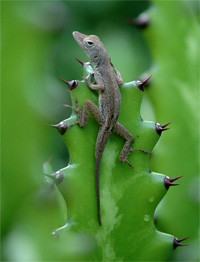 9 April 2006/Sunday/Deshaies, Guadeloupe
9 April 2006/Sunday/Deshaies, Guadeloupe
We took up the anchor at Ile Cabrits at 0730 this morning. We had a
rollicking sail between Ile Cabrits and the southern end of Guadeloupe,
which is about 10 miles. The clean bottom really made a difference. We were
sailing and moving 7.5+ knots easily through the water. The wind was from
the east on our beam and both sails were pulling. Once we got in the lee of
Guadeloupe, the steady wind dropped and Dave turned on one engine to
motor-sail. We were not moving as fast as we did when we were sailing. The
bullets of wind came blasting down the volcanic mountains every so often,
but the boat moved nicely along.
Our plan was to move along the coast to Baie Deshaie, the most northern
location with a Customs office. We anchored off the village of Deshaie at
1325. We ate lunch, then Dave and I took the dinghy into the two-street
village to look around. There are very tall volcanic mountains behind the
village and it had been raining up in the mountains since we had been able
to see them. As we got to the town dock, it started raining hard in the
anchorage, then it stopped. Not a pretty day. We headed out of the village
and up a hill to locate the Customs office. No one was there today, but we
want to check out first thing tomorrow morning. We have talked to two people
who have assured us it will be very difficult to sign out of Guadeloupe here
and told us we should have signed out somewhere else. So far, our experience
has been just the opposite when we hear something like this. So far, so
good.
On the edge of the village a lady was standing under a huge umbrella with
two hand-crank ice cream freezers. I asked if she had ice cream in French.
She said "Sorbet". I asked what kind and she did not seem to realize I was
speaking French or that I understood her. She spoke to me with exaggerated
slowness and said in French that she had two kinds..."co...co" (she said
this like the word for "coconut" had ten syllables) pointing to one freezer.
She pointed to the other freezer and said "co...co...et...go..ya...ve" (she
said this like it had fifteen syllables). I asked how much it cost in
French. She dug out a 2 Euro coin and showed it to me. I don't think this
lady hears anything anyone says. She has her speech all ready and tells
everyone what kind of sorbet and how much without prompting. I was laughing
and so was she as she scooped out my coco-goyave sorbet into a cup. It was
yummy! I told her "C'est delicieuse" and she smiled a bigger smile.
We walked the length of the town to see what is there and spotted two
boulangeries for baguettes. We will come in early tomorrow morning to check
out with customs, so we might as well buy bread while we are at it. Our
guess is the Customs people will be in their office to "clean up" all the
paperwork from the boats that anchored here over the weekend and are flying
yellow quarantine flags. These are the boats that came in from another
country (Nevis and St. Kitts? St. Martin? St. Barts? Antigua?) and are
waiting to sign in to Guadeloupe.
It was raining again, so we hurried back to the boat to get out of the
rain.
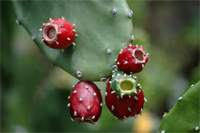 8 April 2006/Saturday/Ile Cabrits, Les Saintes
8 April 2006/Saturday/Ile Cabrits, Les Saintes
We had some very strong rain storms that lasted a long time come through
last night. The rain was pounding on the deck and it was very noisy inside
the boat. The wind had totally changed direction. There was a big swell
coming into the anchorage and all of the boats were bouncing around like
they were at sea on a rough trip. We decided we were going to leave this
anchorage and move over about one mile away in the lee of Ile Cabrits.
First, I wanted to get some tomatoes and cucumbers plus fruit at the market.
Of course I wanted to get fresh baguettes, too. Dave still wanted to get the
jerry jugs filled with water, so he took me in to the town dock and dropped
me off. He went to get water while I did a little shopping. He returned to
pick me up at 0930.
We took the anchor up at 1050 and put it down again at Ile Cabrits by
1115. We were the 7th boat to anchor in this area. By late afternoon, there
were 21 boats anchored there. The wind continued to blow and the swell
continued to come into the anchorage we left in the morning. Dave got caught
up on several jobs that needed to be done. One of the supports for the port
wind generator needed attention, so that was the main job for the afternoon.
David cleaned the bottom of the boat. This warm water makes long sticky
grass grow. The grass comes off easily when it is lightly scraped, so the
bottom paint is working, but it is too bad it is illegal to use the kind of
bottom paint that doesn't let the plants grow there in the first place. The
boat sure looked better with a clean bottom. I did inside boat jobs, so we
are looking tidy inside and out.
The swell continued to come out of the east all day, but that won't be a
problem for us if it continues into tomorrow when we want to head north. We
will be on a beam reach (wind hitting the side of the boat).
 7 April 2006/Friday/Bourg de Saintes, Ile Terre de Haut
7 April 2006/Friday/Bourg de Saintes, Ile Terre de Haut
It rained really hard for a long time several different times in the night.
We were grateful for the free boat wash. The morning dawned bright and sunny
and we were also grateful for that. We wanted to go up to the fort this
morning.
After going into shore, we started walking on the concrete road that
follows the contour of the water along the shore before it starts going back
and forth across the high hill where the fort is located. Several people
were walking up the hill, but most of the day-trippers from Guadeloupe and
the people off the cruise ship anchored outside the bay chose to go up the
hill in taxis or on rented scooters. The taxis and scooters buzzed right by
those of us who were walking and we had the road to ourselves. Along the
way, we passed cactus trees twice as tall as we were. Under the cactus
trees, we spotted a couple of iguanas and there were too many small lizards
to count. We got some good photos of the iguanas. There are many signs
warning that iguanas are protected on the island. We also got good photos of
the village below us and the bay with all the boats anchored there.
It took about 45 minutes to walk up the steep road to the top of the
hill. We paid a small fee to go inside Fort Napoleon. Passing through the
tunnel, it was impressive to walk out into the sunlight inside the walls of
the beautifully renovated fort. There was a huge two-story building inside
the fortified walls that is now used as a museum. The landscaped grounds of
the fort have been turned into a botanical garden. There were many tropical
plants there, but the largest number belonged to the cactus family. There
were several huge iguanas sunning themselves among the cacti. They must be
able to read the signs saying they are protected, because they sure were not
afraid of the people passing by. The museum was very interesting. There was
a room with information and items pertaining to Colombus. There was a room
about the history of Les Saintes. Once again we read the story of how
British Admiral George Rodney left Pigeon Island outside what is now Rodney
Bay, St. Lucia, in 1782 for his most decisive naval battle named the Battle
of The Saintes (referring to the small islands off Guadeloupe). From the
ramparts of this fort, we could look over to Ile Cabrits and see the ruins
of Fort Josephine at the top of the highest hill on the island. Fort
Josephine was used as a prison and in the museum we saw an old photo of
prisoners breaking rocks with hammers.
We walked back down the steep hill and stopped at the 8 a' Huit
mini-market to buy slices of ham and a package of Emmenthal cheese. We
stopped by the boulangerie and bought fresh baguettes to make sandwiches at
the boat. We all love baguette sandwiches with ham, cheese, tomato, lettuce,
onion, cucumber, fresh basil, and Dijon mustard. Having fresh French bread
is a real treat.
In the afternoon, a Privilege 39 like ours came into the anchorage. When
Dave went on an errand into the village, he stopped by the Privilege, named
AQUARIUS. Dave met Carl and Judy from California. They invited us to come
over around 1700 for snacks. We did go over and talk with them and their
friends, Bob and Marcy on GODIVA, also a catamaran. Before we could go over
to AQUARIUS in the evening, Dave had to overhaul our dinghy outboard motor.
He was going into the shore to talk to someone about getting some water when
the engine quit running. Dave paddled back to the boat and started tearing
the engine down. He was able to fix it after working on it for over an hour.
He found the problem was a throttle cable that is stretched, so now is too
long. He jury-rigged something and made it work again. There is a Yamaha
dealer in Dutch St. Maartin, so we will look there for a new throttle cable.
This one seems to be working for now.
When we made it to AQUARIUS, we talked about catamarans, of course. Turns
out Carl and Judy kept their boat at the Dog River Marina in Mobile,
Alabama, for two years, and yes, they know Tom and Bette Lee. We are going
to start asking everyone we meet if they know Tom and Bette Lee! How strange
is that? We meet people from South Africa and California in Les Saintes in
two days and we end up talking about mutual friends. As I have said
before...small world.
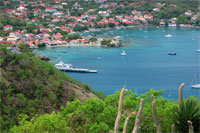 6 April 2006/Thursday/Bourg des Saintes, Ile Terre de Haut (Les Saintes/The
Saintes Islands)
6 April 2006/Thursday/Bourg des Saintes, Ile Terre de Haut (Les Saintes/The
Saintes Islands)
We left Portsmouth, Dominica, at 0735 this morning to head north to the
group of small French islands located 8 miles south of Guadeloupe called Les
Saintes. There are eight small islands in this group and we stopped at Terre
de Haut, the largest island in the group. It is 3.1 miles long and 1.5 miles
wide.
We anchored off the village called Bourg des Saintes at 1150. There were
a lot of transient boats anchored there, and there was a constant stream of
ferries coming from Pointe a Pitre in Guadeloupe bringing day-trippers over
to spend several hours on Terre de Haut. The village has two streets
paralleling the shore. These streets are lined with restaurants, cafes, and
shops within easy walking distance of the ferry dock.
After we ate lunch on the boat, Dave and I went into shore to check into
Guadeloupe (Les Saintes are under French jurisdiction through the local
government on Guadeloupe). We enjoyed walking through the village and seeing
the tidy white buildings with red roofs lining the cobblestone streets. The
village is very picturesque. The Customs officials were located in an office
at the marie (city hall). They took our boat papers and asked us to return
in one half hour. They copied our boat papers and faxed them to headquarters
in Guadeloupe. When we went back thirty minutes later, we were officially
entered into Guadeloupe.
We walked through the rest of the village, keeping our eyes open for
French breads, baguettes, and pastries. There are many shops that sell bread
and pasteries, but all the fresh goods were sold out. If you want fresh
bread, you have to get it early in the morning. There were several small
grocery shops with all the basics available.
On the highest hill overlooking the anchorage and village, there is a
restored fort. We want to hike up there and see the fort, plus the view from
up there must be terrific. We decided to do that tomorrow morning if the
weather is nice.
We stopped by the catamaran SPIRIT OF ECSTASY and met the people on
board. They had swung by us and asked where Customs was located and if they
were open when they arrived today. At the time, we had not been into shore,
so after we did sign in, we stopped by to tell them where we found Customs
and about the procedure. Ian and Louise invited us on board for a cup of
tea. They are from St. Francis Bay, South Africa. We told them our friends,
Tom and Bette Lee, have a St. Francis 48 catamaran that was built in St.
Francis Bay. Turns out, these folks know Tom and Bette Lee! Small world.
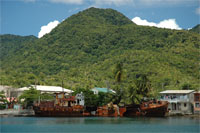 5 April 2006/Wednesday/Prince Rupert Bay, Portsmouth, Dominica
5 April 2006/Wednesday/Prince Rupert Bay, Portsmouth, Dominica
We let go of the mooring ball in Roseau at 0850 this morning. There was very
little wind in the shadow of the island. We put up the mainsail and tried to
use the foresail, but it kept filling, then dumping wind as we moved along
the coast. The high mountains make what wind there is, very unpredictable.
We motorsailed and arrived in Portsmouth, Dominica, at 1235.
Portsmouth is the second-largest town on the island, but it only has two
long streets paralleling the long sandy beach at the edge of Prince Rupert
Bay. The town fits in the small flattish area between the sea and high
volcanic mountains that cover most of the island. The guide book says that
Portsmouth was originally chosen to be the capital of the island in the
1500's, because the bay is the best anchorage on the island. The near-by
marsh became a problem when people got malaria. Roseau was chosen as the
capital because the area was "healthier".
We came in the south end of the bay and did a run along the shore taking
photos and video before we anchored on the northern end. It was a big
surprise to see two small rusting freighters and one large rusting freighter
laying on the beach. The large boat was just a few feet from several houses.
We found out later these ships were washed ashore in Hurricane David in
August 1979. If there were people in those house on the beach during the
storm, seeing those ships washing toward them must have been terrifying.
After lunch we dinghied into shore and left our dinghy at Big Papa's
dock. There was quite a big swell coming in, so we were glad we brought the
stern anchor with us and could anchor at the side of the dock. The dinghies
without stern anchors were being bashed against the end of the dock with
each pounding swell. One man who works for Big Papa came out and asked us
not to lock our dinghy in case they had to move them around, and he promised
they would keep an eye on the dinghy. We had heard security is a problem
here. We also paid this man to take our garbage to Big Papa's bin.
We left Big Papa's at the north end of town and made our way down the
street nearest to the water. There were wooden houses on stilts and newer
concrete houses mixed in with small shops selling interesting combinations
of products. I was looking for bread since I had already decided I would
rather make bread than eat what Dave bought in Roseau. It is interesting to
me that Dominica sits between two French islands (Martinique to the south
and Guadeloupe to the north) with an unlimited variety of light, delicious
French breads, and they choose to eat hard, heavy breads. Dominica was ruled
by the French as much as by the British over a two hundred year period of
time. They speak English as a first language now, but their patois is based
on French. Many of the islanders speak both English and French. Why didn't
the French bread become popular?
After asking how we could get to Ross University, the American medical
school located south of town, we headed for the "bus stop" at the other end
of town where we were told to stand on the sidewalk. Right by the bus stop
we smelled fresh baking bread. I popped into the shop and bought a fresh
loaf of bread just before a maxi taxi stopped to load passengers. We rode in
the maxi taxi for about 15-20 minutes and were dropped at the main gate of
very modern white cement buildings trimmed in aqua. The campus is tidy and
beautiful and overlooks the sea. The security at the gate is very tight. We
told the guard our daughter had told us about the school and we wanted to
see it while we were here. He called several people on the phone and we had
to sign in and put on a badge before we were allowed on campus. One of the
first people we met on the sidewalk stopped to answer a couple of questions
we asked. We talked to the man for about 20 minutes and discovered he and
his wife are new on the faculty of the school. They have been cruising the
Caribbean for four years and and live aboard their catamaran while they are
working in the clinical psychology department at Ross. They are from
Alabama. We had a lot of fun talking to him and wished we were going to be
around Portsmouth longer so we could learn more about their experiences in
Dominica. It seems that Ross University is a big part of the economic story
in the northern part of the island.
We walked around the campus, then crossed the street to Perky's Pizza. We
reckoned a pizza place near any school would have to be pretty good to get
repeat customers. While Dave and David waited for the pizza, I went into
James' Store. This is a medium-size grocery store with all the kinds of
things you would expect expat students to buy. This looked like a
super-center compared to the smaller basic shops we had seen in Portsmouth.
The store had a wide variety of goods, but the snack foods, cool drinks, and
bread were right up front by the cash register. I bought cereal and popcorn.
A maxi-taxi stopped and picked us up immediately, so we were back in town
before it got dark. The guide book suggests the area is safe during the day,
but a little extra caution should be taken after dark. That seems to be true
almost everywhere in the world these days. We walked from the bus station at
the south end of town to Big Papa's at the north end of town where our
dinghy was tied. The sweet smell of ganja was wafting on the night air. I
had to laugh when one of the Rastas asked me if I wanted to buy some. That
is the first time anyone tried to sell me ganja. I decided I must really
look tired today.
About 1900, really loud music started moving through the air and across
the water. We thought one of the hotel restaurants or bars must be having
live entertainment tonight. The music went on for over an hour, so we heard
a lot of it. Turns out, it was a church service. We could hear the music,
then the preaching that went on until almost midnight. If the town and
people don't come to them, they reach out to the town and people by turning
up the microphone. Everyone for miles around could hear what was being sung
and said.
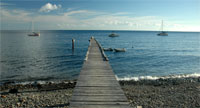 4 April 2006/Tuesday/Roseau, Dominica
4 April 2006/Tuesday/Roseau, Dominica
I stayed on the boat all day today and did some catching up on jobs that
don't get done when we are moving the boat. The swell was coming into the
bay a tad and I didn't really look forward to climbing the shaky dock steps
up from the dinghy to walk on the dock that sticks so far out in the water
and so high above the water from the dive shop. I decided I would rather
stay on the boat than go through all that again two times...before and after
spending a little time on land.
After lunch on the boat, Dave and David took the cameras and walked to
the east side of town to find the botanical gardens. They said it was a
small garden, but they got some very nice photos of a cannonball tree and a
sausage tree. Only someone with a sense of humor could have designed those
trees. This is the time of year the bushes and trees are blooming, so they
got some nice shots of colorful blooms of all sizes and descriptions. One
banyan tree was of particular interest. The tree was blown over in Hurricane
David which hit Grenada hard in August 1979. The tree fell directly on a
yellow mini-bus and squashed it. The bus is still in place under the old
trunk of the tree and the tree has sent a new trunk reaching to the sky.
Of course, we remember Hurricane David well because both Hurricane David
and Hurricane Frederick came near where we were living at Roosevelt Roads
Naval Station, Puerto Rico, within days of each other. We owned a Triton 28
sailboat at the time and had it kitted out to go on our first cruising
holiday with our very young children. The hurricane caused us to reschedule
those plans. We have often told Wendy and David about those hurricanes. This
was the first time Dave and I had experienced the eye of a hurricane passing
over us. David was 6-7 weeks old and he slept through all of the hullabaloo
in a woven Moses basket. Wendy was a couple of months less than 2-years-old
at the time and was old enough to know something exciting was happening.
To the back of the Roseau botanical gardens there was a marked trail that
went up the mountain behind the town. Dave and David followed the trail and
ended up on an overlook with a splendid view of the town at the edge of the
ocean, the south and north ends of the island, and the seemingly endless
ocean. The top Supreme Court Justice of Dominica lives up on the mountain
with an armed guard at her property line. She must have to make some tough
decisions that everyone doesn't agree with.
I asked Dave to bring some bread and ice from town when they returned to
the boat. They brought both. The ice was a real treat. The bread was a long
bread about 12 inches long, thicker in the middle, tapered at the ends, and
heavy enough to be declared a concealed weapon. I can't imagine eating this
bread dry. Maybe they use this bread to sop up the local stews and soups
that seem to be so popular. Maybe they are using cassava or dasheen (roots
of elephant ear plant) flour to make the bread and that is why it is so
heavy.
We will be moving north to Portsmouth, Dominica, tomorrow morning.
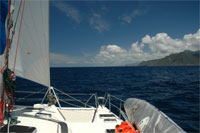 3 April 2006/Monday/Roseau, Dominica
3 April 2006/Monday/Roseau, Dominica
We left St. Pierre, Martinique, at 0620 this morning. The winds went down in
the night and the southerly swell was completely gone. We had light easterly
winds pushing us along once we came out from behind Martinique and were in
the channel between it and Dominica.
We stopped at Roseau, Dominica at 1315. This island is volcanic and has
many high mountains. The book says the wind can blast down the mountains and
the shore is steep to. The anchorage at the Anchorage Hotel outside Roseau
is quite a distance from town. We decided to pick up a mooring that is near
town. The mooring is in 75 feet of water and is owned by a dive shop with a
very long pier coming over the water where we can tie up the dinghy. The
only other boat on a mooring was our friends, Walter, Joe, and Amanda, on
MARNIE. We were surprised to see them and know they were surprised we are
moving so fast we caught up with them. We left Trinidad a week after they
did.
After we had something to eat and were satisfied we were tied well to the
mooring, we put the dinghy in the water and went in to the pier, then into
the dive shop to pay for the mooring. We walked toward town to Customs,
located on the ferry dock. There was a huge cruise ship in town today, so
Customs was busy and Dave had to wait about a half hour to get in the
building to check in to Dominica. He did a three-day check in and out when
he saw Customs.
We walked around town looking for a grocery store. We found one, but we
were looking for soft drinks and they didn't have much variety. We bought
some strange- named local pop because that is what was available and
everyone told us this was the biggest store in town. We thought it was
small-to-medium size. Dave went into a pharmacy and found some food and soft
drinks in there. We were able to buy both Diet Coke and Diet Dr. Pepper. It
doesn't get any better than that.
Dave and David were carrying bags full of pop and I was pulling a
heavily-loaded Elvin. Fortunately, the dive shop was mostly downhill from
town. When we arrived at the dive shop and pier, there was a local man with
a green 110 Land Rover truck. We had never seen one like this, sort of a
short 130. He does off-road 4x4 tours in his Land Rover. He and Dave had
quite a talk about modifications as the man is looking to do some to his
vehicle. We gave him our website name so he can go there and see what our
vehicles looked like. He wants us to sign up for a tour, but he is busy
until Thursday, so I don't know what we will decide to do.
Dominica is 29 miles long and 16 miles wide. It has 8 active volcanoes.
Most people come here to do rainforest hikes and mountain hiking. The island
was British for many years, so English is the first language. It is located
between French Martinique to the south and French Guadeloupe to the north.
The two main stops at this island are Roseau, the capital, and Portsmouth at
the north end of the island. We haven't decided what activities we are going
to do here.
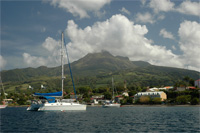 2 April 2006/Sunday/St. Pierre, Martinique
2 April 2006/Sunday/St. Pierre, Martinique
This is quite a beautiful anchorage and waking up to see Mt. Pele'e, the
volcano, standing tall above the surrounding land is impressive still today.
We were able to take photos of the volcano without clouds covering the top.
The sides of the volcano are covered with crops, so the volcano appears to
be green. The volcano is 4.3 miles north of the town.
After taking our dinghy into the town dock, we walked around the first of
two streets that parallel the shore. There was a crowd of people in the town
square on the waterfront in front of the "8 a' Huit" (this means 8 to 8, but
the shop is really open from 0800-1930. I guess that was too long for a
store name.). Today the shop was open from 0800-1230. The town square had
benches made in squares around palm trees for shade, interspersed with
flowering bushes. Many local people were sitting around visiting with their
friends. A few souvenir shops and cafes were open. There was no cruise ship
in today.
We walked back to the second street running parallel to the shore. There
were more shops and cafes, but very few were open. We did spot Marina Pizza
with its stack of empty carry-out pizza boxes ready for business. We
carefully noted the hours they would be open. The sidewalks were only wide
enough for one person and if a car parked so one side of it was on the
sidewalk, you had to walk in the street to get around the car. The one-way
traffic on both streets was steady. We reckon this road must be the one that
goes around this part of the island and everyone had to drive through St.
Pierre. We had to be very careful crossing the street and walking around
parked cars.
Last night we could see lighted stone walls standing on the shore to the
north side of town. In the light of day, we stood at the top of these walls
and realized these were walls that had survived the volcanic eruption. From
a distance, the town looks dirty, but once we were standing on the streets,
we saw a very tidy, neat town made up of colorful buildings that have
incorporated the gray and black lava rock into the town's reconstruction.
The modern building we found on top of the stone wall is the local volcano
museum. Inside, we saw photos of how the town looked in its heyday. In 1902
before the volcano erupted on 8 May, St. Pierre was the capital of
Martinique with a population of 30,000. Rich estate owners used this bay to
export cocoa, coffee, sugar, and rum all over the world. St. Pierre was
known as the "Paris of the Caribbean". It was the social, cultural, and
economic center of Martinique. Ships stopped here from all over the world to
sell and buy goods.
On 8 May 1902, at 0802 the side of the volcano above St. Pierre glowed
red and burst open. A giant fireball of gas containing more energy than an
atomic bomb was released onto the city. An estimated 29,933 people were
instantly killed by the poisonous gas or later by the hot lava and fires.
Twelve ships anchored in the bay were destroyed. Some stories say a few
survived the eruption, but most stories only tell about Cyparis. He was
imprisoned in the solitary confinement cell of the prison because he
murdered someone. The thick walls of the cell saved his life. Cyparis was
found injured, but alive, four days after the disaster occurred. After he
was well again, he went to the U.S.A. and joined Barnum and Bailey's Circus,
billed as the "only survivor of Mt. Pele'e's eruption".
These historical facts are well-documented in the museum. Everyone seems
to come away with questions about volcanoes and earthquakes. Don't volcanoes
give signs of activity before they "really blow"? One book we read about
Martinique said there had been rumblings on the mountain in April 1902. On 2
May 1902 enough ash came out of the volcano to kill birds and animals. That
same day, one planter went to check the damage the ash had done to his crops
on the south side of St. Pierre. He and the workers with him were swept away
in a sea of boiling volcanic mud. On 5 May 1902, an estate north of St.
Pierre disappeared under a flow of mud, lava, boiling gases, and rocks that
covered an area one quarter mile wide and 100 feet high.
The logical question is "Why didn't they evacuate St. Pierre?". The book
says the local estate owners did not want to stop the commercial flow of
products going in and out of the city. They would face financial ruin. They
didn't want to admit there was a problem. The in-experienced Governor of the
island had been in the Caribbean less than a year and did not want to
evacuate the city because the process would be difficult and would allow the
world to know there was a problem "on his watch". He encouraged people to
stay in St. Pierre and took his own family there to prove how safe it was to
be there. Elections were coming up and the politicians did not want anything
to stop them. The politicians asked the local paper to print articles about
how it was safe to be in St. Pierre.
Today, 6,000 people live in a small town of St. Pierre. In 2002 the town
had a 100-year celebration remembering the destruction of St. Pierre in 1902
and probably being thankful that it had not happened again since then. We
left the museum and walked farther down the street to the site of the
destroyed theater and prison. The theater has stone structure left to tell
it was a theater. The prison is all footings of stone buildings except for
the solitary confinement cell that is still standing. Very impressive to
stand in these ruins and look up at Mt. Pele'e "looking" down at us. We
backtracked to the center of town, stopping on the way at the Marine Pizza.
I went ahead to 8 a' Huit and bought ice cream and cold drinks. We met again
at the town square and had our lunch sitting in the shade of a palm tree by
the waterfront.
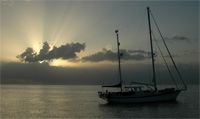 1 April 2006/Saturday/Fort de France, Martinique
1 April 2006/Saturday/Fort de France, Martinique
We marveled at what a nice anchorage this is...right off the town, great
dinghy dock, few boats in the harbor so there is plenty of room, etc. We
were to remember these thoughts later in the day.
We took the dinghy into town and had a look around this morning. Since it
was Saturday and there was no cruise ship in port, many of the shops did not
open today. The ones that were open, stayed open until 1300 or 1400. The
town has a population of 100,000. The downtown area is concentrated along
the harbor. There were a lot of souvenir shops selling the usual carved and
woven bits and pieces. There were a lot of fabric stores selling many
fabrics. The most expensive fabric, which is almost like a souvenir itself,
is the orange-based multi-color plaid worn by many of the older ladies. We
have seen variations of this plaid in St. Lucia and Martinique. I believe we
will also see it in Dominica and Guadeloupe. The skirts are made of bands of
the plaid material separated by strips of white lace. The plaid skirts are
usually worn with a lacy white blouse.
We looked at the fruit and vegetable market that the locals go to on
Saturday mornings. We arrived late in the morning, so there weren't many
people shopping. If you want the best choices, you have to get to these
local markets by 0700. The market was located near the big park in town. We
were hoping to find trees and plants in bloom so we could photograph them,
but there weren't many flowering plants at this time of year.
We walked back to town to find something to eat. Dave opted for Kentucky
Fried Chicken, while David and I chose Delifrance, where we bought ham and
cheese baguette sandwiches. On the way back to the dinghy, we bought some
French baguettes and croissants. Most of the shops were closing as we
arrived at the dinghy. Within fifteen minutes of our arrival at the boat,
six more yachts came into the anchorage to anchor and three of them were
quite big. We were just discussing whether or not to leave and seeing all of
these yachts crowd into the anchorage helped us make up our mind to leave.
The anchor came up at Fort de France at 1350 and we sailed down the
protected west coast of the island to San Pierre, arriving at 1640. We were
surprised to be pushed along by a wind from the east and a swell coming from
the south. We have no idea what caused the swell, but it pushed us right
along. Of course, the bay at San Pierre is protected from the east, so we
had wind protection, but the southerly swells were rolling right in to the
beach. This made being at anchor a tad rolly. We weren't doing too badly,
but some of the monohulls were rolling through quite an arc. We anchored,
hoping the southerly swell would die out soon without a southerly wind to
reinforce it.
San Pierre is the town that was destroyed by a volcanic eruption in 1902.
We are really looking forward to going into town and seeing the museum, etc.
